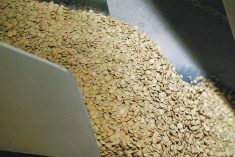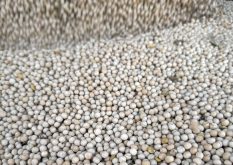India's expanding poultry sector is one option for American exporters as China continues to buy more beans from Brazil
SASKATOON — The United States is eyeing new markets for its soybeans as China continues its shift to Brazilian beans.
India is one up-and-coming market where the U.S. sees tremendous potential.
Related stories:
Poultry production is expanding by six per cent per year in the world’s most populated country, Lance Rezac, chair of the U.S. Soybean Export Council (USSEC), said during a recent webinar hosted by Agri-Pulse Communications.
Read Also

Fertilizer Canada-led campaign highlights environmental stewardship
Make Your Acres Count campaign aids Alberta farmers in getting recognized for their environmental stewardship in their crop production.
India appears to have enough domestic soybean production to meet the feed demand from that sector for the time being.
However, there is no surplus production, and in years where the domestic crop is poor, India’s poultry sector has been forced to import soybean meal.
Rezac thinks that will become a more common practice in the coming years due to the rapid growth in India’s poultry industry.
“That is a market that will show up and it is where the population is,” he said.
However, tariffs continue to be a problem in India, where the government is trying to appease 800 million farmers.
Pakistan also has big potential.
The U.S. was making inroads in that market after it showed the country’s poultry farmers how to employ U.S. production methods.
“They changed their whole poultry production over in three or four years,” said Rezac.
However, just as it started to show some promise, a new government was elected that shut down the importation of genetically modified soybeans.
Pakistan’s poultry production immediately fell by about 75 per cent.
Groups such as USSEC have been “cautiously” working with Pakistan’s government to re-open imports.
“I think that would be a real good market to get us going,” he said.
Algeria is another target. It recently built a couple of big crush plants and is starting to purchase some soybean meal.
Jim Douglas, board member of the U.S. Meat Export Federation, said the U.S. has never had much exportable supplies of soybean meal due to ample domestic demand for the product.
However, that is changing as new crush plants are built to supply the renewable diesel and sustainable aviation fuel industries with soybean oil, resulting in excess soybean meal production.
Douglas said it will take time to build a customer base for that product.
A good way to boost demand for the product is by increasing U.S. pork exports because 24 per cent of the country’s soybeans are already exported in the form of pork.
Mexico, South Korea and Central America are huge growth markets for pork consumption.
He also believes there is big potential in Cuba as diplomatic tensions subside between that country and the U.S.
“There is demand right off our shoreline that has basically been untapped,” he said.
Rezac said the U.S. will continue to face stiff competition from Brazil, a country that produces two crops of soybeans a year, receives 1,800 millimetres of rain annually and faces very little environmental restrictions.
It also has 100 million acres of pasture that can be converted to farmland.
“They have almost unlimited resources,” he said.
However, they also have a big vulnerability. Rezac was in Brazil earlier this year and saw farmers harvesting wet soybeans that were dried with wood, which results in poor quality soybeans.
“The Chinese won’t buy Brazilian beans for their reserves. They’ll buy Argentinian or U.S.,” said Rezac.
Douglas said he recently inspected South American beans at a feed mill in Indonesia.
“It’s clearly an inferior product,” he said.
“It rains every day during (Brazil’s) harvest, so they don’t have a good quality product and therefore you don’t make as good a feed out of it.”
However, Indonesia’s poultry industry is in its infancy. Producers are solely focused on price and are not paying attention to quality attributes.
That will change as the country’s poultry farmers become more educated, and he thinks it will level the playing field with Brazil’s cheap beans in that market and others.
Rezac said the U.S. also has a sustainability advantage over Brazil in markets that care about that, such as the European Union, South Korea and Japan.
It’s why the U.S. soybean industry was disappointed when the EU delayed its proposed Regulation on Deforestation-free products by one year to Dec. 30, 2025.
The goal of the regulation is to prohibit imports of products such as soybeans and palm oil grown on recently deforested land.
The regulation would have affected about 5,000 acres in the U.S. compared to millions of acres in Brazil, he said.
“That should really, really be to our advantage,” said Rezac.
“I was kind of disappointed that they delayed that.”
Contact sean.pratt@producer.com
















